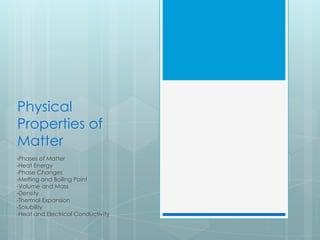Report
Share

More Related Content
What's hot
What's hot (20)
11 particulate model (changes in state & temp curves)

11 particulate model (changes in state & temp curves)
Viewers also liked
Viewers also liked (14)
Keynote speach at Hands On! Children's museum conference - 2009

Keynote speach at Hands On! Children's museum conference - 2009
Similar to Physical properties of matter
Similar to Physical properties of matter (20)
More from flippinscience
More from flippinscience (14)
Scientific investigations, reporting and analyzing data,

Scientific investigations, reporting and analyzing data,
Recently uploaded
Recently uploaded (20)
CNIC Information System with Pakdata Cf In Pakistan

CNIC Information System with Pakdata Cf In Pakistan
Apidays New York 2024 - APIs in 2030: The Risk of Technological Sleepwalk by ...

Apidays New York 2024 - APIs in 2030: The Risk of Technological Sleepwalk by ...
WSO2's API Vision: Unifying Control, Empowering Developers

WSO2's API Vision: Unifying Control, Empowering Developers
AWS Community Day CPH - Three problems of Terraform

AWS Community Day CPH - Three problems of Terraform
Six Myths about Ontologies: The Basics of Formal Ontology

Six Myths about Ontologies: The Basics of Formal Ontology
Vector Search -An Introduction in Oracle Database 23ai.pptx

Vector Search -An Introduction in Oracle Database 23ai.pptx
Strategies for Landing an Oracle DBA Job as a Fresher

Strategies for Landing an Oracle DBA Job as a Fresher
Boost Fertility New Invention Ups Success Rates.pdf

Boost Fertility New Invention Ups Success Rates.pdf
DEV meet-up UiPath Document Understanding May 7 2024 Amsterdam

DEV meet-up UiPath Document Understanding May 7 2024 Amsterdam
Why Teams call analytics are critical to your entire business

Why Teams call analytics are critical to your entire business
Introduction to Multilingual Retrieval Augmented Generation (RAG)

Introduction to Multilingual Retrieval Augmented Generation (RAG)
Navigating the Deluge_ Dubai Floods and the Resilience of Dubai International...

Navigating the Deluge_ Dubai Floods and the Resilience of Dubai International...
EMPOWERMENT TECHNOLOGY GRADE 11 QUARTER 2 REVIEWER

EMPOWERMENT TECHNOLOGY GRADE 11 QUARTER 2 REVIEWER
Modular Monolith - a Practical Alternative to Microservices @ Devoxx UK 2024

Modular Monolith - a Practical Alternative to Microservices @ Devoxx UK 2024
How to Troubleshoot Apps for the Modern Connected Worker

How to Troubleshoot Apps for the Modern Connected Worker
Connector Corner: Accelerate revenue generation using UiPath API-centric busi...

Connector Corner: Accelerate revenue generation using UiPath API-centric busi...
Physical properties of matter
- 1. Physical Properties of Matter -Phases of Matter -Heat Energy -Phase Changes -Melting and Boiling Point -Volume and Mass -Density -Thermal Expansion -Solubility -Heat and Electrical Conductivity
- 2. Phases of Matter The most common phases of matter are solid, liquid, and gas phases. Solids have a definite shape, but no definite volume Liquids have a definite volume, but no definite shape Gases don’t have a definite volume or shape
- 3. Heat Energy Energy that makes particles of matter move faster is heat energy The more heat energy an object has obtained, the faster its particles will move Temperature is the amount of heat energy an object has The relationship between temperature, heat energy, and matter is how phase changes occur
- 4. Phase Changes When heat energy moves into a solid, eventually the motion of the particles will overcome the attraction they share and the solid will melt into a liquid. However, these particles are still attracted to each other. When more heat is added to the newly formed liquid, particles will move even faster, escape, and the liquid will change into a gas. This is called vaporization. Phase changes are reversible. Condensation is when a gas phases back into a liquid. Sublimation is when a substance changes from a solid to a gas, skipping the liquid phase. Deposition is when gas particles become solid without becoming a liquid first. An example of this is dry ice, frozen carbon dioxide.
- 5. Melting and Boiling Points The melting point is the temperature at which a solid becomes a liquid. Water has a melting point of 0˚ Celsius; Iron has a melting point of 1538˚ Celsius. Nitrogen melts at -210˚ Celsius. Boiling point is the temperature at which a substance changes phase from liquid to gas. As more heat energy is put into a liquid, particles move faster and exert a pressure called vapor pressure. When the vapor pressure is equal to the air pressure the liquid starts boiling and the particles escape from the liquid and become a gas.
- 6. Volume and Mass Volume is the amount of space an object occupies. It is usually measured in cm 3 or mL. Mass is the amount of matter that makes up an object. It is usually measured in grams or kilograms. The mass of an object depends on the number and types of particles it contains. Volume measured in cubic centimeters
- 7. Density Density = mass volume Thedensity of an object depends on an objects mass and volume.
- 8. Thermal Expansion During phase changes, the mass of a substance stays constant but it’s volume may change. Most solids and liquids increase in volume as they heat up and thermal expansion occurs. When a substance vaporizes from a liquid to as a gas, its volume increases immensly.
- 9. Solubility A solute is a substance that is dissolved. A solvent is the substance that dissolves the other. If the particles from the solvent are evenly distributed throughout the solute, then a solution is formed. Solubility is the degree of which a solute will dissolve into a solid
- 10. Heat and Electrical Conductivity Conductivity is a substance’s ability to transport heat or electrical energy from one destination to another. If a substance has high conductivity, heat and electrical energy will pass through it quickly, like most metals.